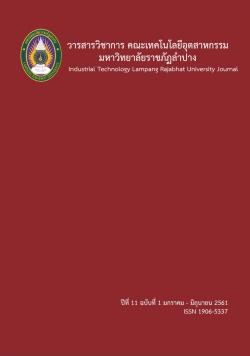Indoor Positioning Using Wireless Lan Network Signal : a Case Study of Technology and Engineering Laboratory Building, Faculty of Industrial Technology Uttaradit Rajabhat University
Keywords:
Indoor positioning, Wireless signal strength, Position data processingAbstract
Limitation of GPS System for indoor using is the obstacle of satellite signal which is unable to calculate for the position. The objectives of this research are development of indoor positioning system using wireless lan network signal and received signal strength indicator (RSSI) as the comparative information along with data comparing module (DCM) and positioning error from data position processing in 3 methods, namely 1) Mode 2) Minimum Mean Square Error and 3) Minimum Standard Deviation. Research. The Result for the room with 8 metres width and the length 10 metres. Together with three access points installed using minimum mean square error has minimum average error at 2.33 metres which is close to minimum average standard deviation at 2.38 metres. For indoor case on 1st, 2nd and 3rd floor using the existing access points. Mode for position data processing found that minimum error average equals to 7.10 metres which is close to minimum average mean square error at 7.45 metres and differ from minimum standard deviation with in statistical significance at confident level of 95% (p<0.05). This research indicates that in the area of access point the signal strength the positioning error decrease. Moreover, the most accuracy in position processing is minimum mean square error, it is suitable for applying to indoor positioning system using wireless LAN network signal along with data comparing module (DCM).
References
Harville, D. A. and Jeske, D. R. (1992). Mean Squared Error of Estimation or Prediction under a General Linear Model, Journal of the American Statistical Association, 429(84), 724-731.
Jaroenrat, K. and kaiprasitthaworn, J. (2012). Positioning system on wireless lan, paper presented in the 4 Rd NPRU National Conference 2012, Nakhon Pathom, Thailand. (in Thai)
Kemppi, P., (2005). Database Correlation Method for Multi-System Location. The degree Master of Science in Electrical and Communications Engineering, Department of Electrical and Communications Engineering, Espoo Finland.
Kotanen, A. et al. (2003). Positioning with IEEE 802.11b wireless LAN, paper presented in the 14th IEEE Proceedings IEEE Conference Publication, Indoor and Mobile Radio Communications, Tampere University of Technology, Finland.
Laitinen, H., Lahteenmaki, J and Nordstrom, T., (2001). Database Correlation Method for GSM location, paper presented in the IEEE 51st VTC, Rhodes, Greece.
Maneerat, K., (2012). Development of Wireless Indoor Positioning Systems for Multi-Floor Building Using Hybrid. Nakhon Ratchasima: Suranaree University of Technology. (in Thai)
Medhi, J., (1992). Statistical Methods: An Introductory Text. New Delhi: New Age International.
Paramvir, B. and Venkata N., P. (2000). RADAR: an in building RF based user location and tracking system, paper presented in the IEEE Computer and Communications Societies, Tel Aviv, Israel.
Satasaowapak, P. and Khunboa, C. (2009). indoor object location system using Wireless Sensor Network (IEEE 802.15.4). paper presented in the ECTI-CARD 2009, 149-154. (in Thai)
Xu, L., Yang, F., Jiang, Y., Zhang, L., Feng, C., and Bao, N. (2011). Variation of Received Signal Strength in Wireless Sensor Network, 3rd International Conference on Advanced Computer Control (ICACC), pp. 151-154.
Yamane, T., (1967). Statistics: An Introductory Analysis, 2th edition. New York: Harper & Row.






